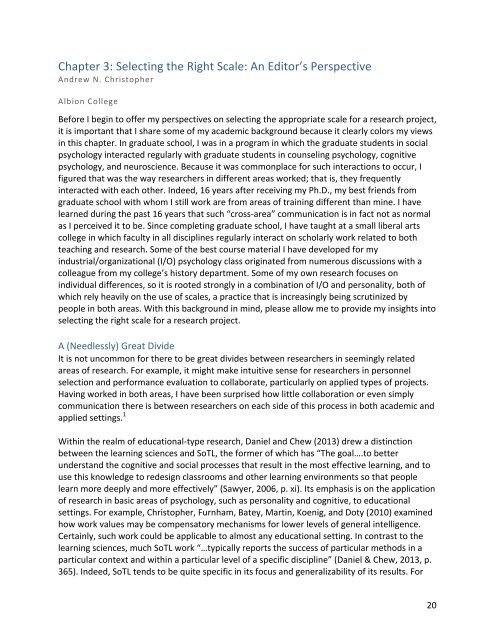A COMPENDIUM OF SCALES for use in the SCHOLARSHIP OF TEACHING AND LEARNING
compscalesstl
compscalesstl
Create successful ePaper yourself
Turn your PDF publications into a flip-book with our unique Google optimized e-Paper software.
Chapter 3: Select<strong>in</strong>g <strong>the</strong> Right Scale: An Editor’s Perspective<br />
Andrew N. Christopher<br />
Albion College<br />
Be<strong>for</strong>e I beg<strong>in</strong> to offer my perspectives on select<strong>in</strong>g <strong>the</strong> appropriate scale <strong>for</strong> a research project,<br />
it is important that I share some of my academic background beca<strong>use</strong> it clearly colors my views<br />
<strong>in</strong> this chapter. In graduate school, I was <strong>in</strong> a program <strong>in</strong> which <strong>the</strong> graduate students <strong>in</strong> social<br />
psychology <strong>in</strong>teracted regularly with graduate students <strong>in</strong> counsel<strong>in</strong>g psychology, cognitive<br />
psychology, and neuroscience. Beca<strong>use</strong> it was commonplace <strong>for</strong> such <strong>in</strong>teractions to occur, I<br />
figured that was <strong>the</strong> way researchers <strong>in</strong> different areas worked; that is, <strong>the</strong>y frequently<br />
<strong>in</strong>teracted with each o<strong>the</strong>r. Indeed, 16 years after receiv<strong>in</strong>g my Ph.D., my best friends from<br />
graduate school with whom I still work are from areas of tra<strong>in</strong><strong>in</strong>g different than m<strong>in</strong>e. I have<br />
learned dur<strong>in</strong>g <strong>the</strong> past 16 years that such “cross-area” communication is <strong>in</strong> fact not as normal<br />
as I perceived it to be. S<strong>in</strong>ce complet<strong>in</strong>g graduate school, I have taught at a small liberal arts<br />
college <strong>in</strong> which faculty <strong>in</strong> all discipl<strong>in</strong>es regularly <strong>in</strong>teract on scholarly work related to both<br />
teach<strong>in</strong>g and research. Some of <strong>the</strong> best course material I have developed <strong>for</strong> my<br />
<strong>in</strong>dustrial/organizational (I/O) psychology class orig<strong>in</strong>ated from numerous discussions with a<br />
colleague from my college’s history department. Some of my own research foc<strong>use</strong>s on<br />
<strong>in</strong>dividual differences, so it is rooted strongly <strong>in</strong> a comb<strong>in</strong>ation of I/O and personality, both of<br />
which rely heavily on <strong>the</strong> <strong>use</strong> of scales, a practice that is <strong>in</strong>creas<strong>in</strong>gly be<strong>in</strong>g scrut<strong>in</strong>ized by<br />
people <strong>in</strong> both areas. With this background <strong>in</strong> m<strong>in</strong>d, please allow me to provide my <strong>in</strong>sights <strong>in</strong>to<br />
select<strong>in</strong>g <strong>the</strong> right scale <strong>for</strong> a research project.<br />
A (Needlessly) Great Divide<br />
It is not uncommon <strong>for</strong> <strong>the</strong>re to be great divides between researchers <strong>in</strong> seem<strong>in</strong>gly related<br />
areas of research. For example, it might make <strong>in</strong>tuitive sense <strong>for</strong> researchers <strong>in</strong> personnel<br />
selection and per<strong>for</strong>mance evaluation to collaborate, particularly on applied types of projects.<br />
Hav<strong>in</strong>g worked <strong>in</strong> both areas, I have been surprised how little collaboration or even simply<br />
communication <strong>the</strong>re is between researchers on each side of this process <strong>in</strong> both academic and<br />
applied sett<strong>in</strong>gs. 1<br />
With<strong>in</strong> <strong>the</strong> realm of educational-type research, Daniel and Chew (2013) drew a dist<strong>in</strong>ction<br />
between <strong>the</strong> learn<strong>in</strong>g sciences and SoTL, <strong>the</strong> <strong>for</strong>mer of which has “The goal….to better<br />
understand <strong>the</strong> cognitive and social processes that result <strong>in</strong> <strong>the</strong> most effective learn<strong>in</strong>g, and to<br />
<strong>use</strong> this knowledge to redesign classrooms and o<strong>the</strong>r learn<strong>in</strong>g environments so that people<br />
learn more deeply and more effectively” (Sawyer, 2006, p. xi). Its emphasis is on <strong>the</strong> application<br />
of research <strong>in</strong> basic areas of psychology, such as personality and cognitive, to educational<br />
sett<strong>in</strong>gs. For example, Christopher, Furnham, Batey, Mart<strong>in</strong>, Koenig, and Doty (2010) exam<strong>in</strong>ed<br />
how work values may be compensatory mechanisms <strong>for</strong> lower levels of general <strong>in</strong>telligence.<br />
Certa<strong>in</strong>ly, such work could be applicable to almost any educational sett<strong>in</strong>g. In contrast to <strong>the</strong><br />
learn<strong>in</strong>g sciences, much SoTL work “…typically reports <strong>the</strong> success of particular methods <strong>in</strong> a<br />
particular context and with<strong>in</strong> a particular level of a specific discipl<strong>in</strong>e” (Daniel & Chew, 2013, p.<br />
365). Indeed, SoTL tends to be quite specific <strong>in</strong> its focus and generalizability of its results. For<br />
20


